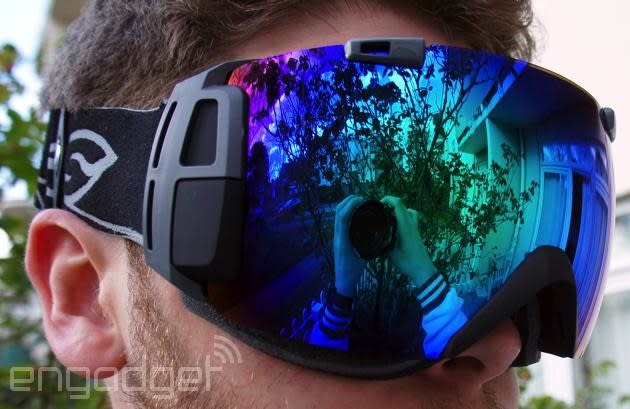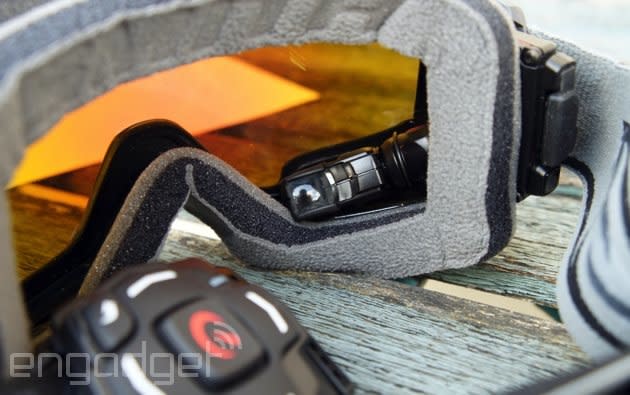IRL: Going skiing with Smith I/O Recon goggles

Welcome to IRL, an ongoing feature where we talk about the gadgets, apps and toys we're using in real life and take a second look at products that already got the formal review treatment.
Does a fortnight of snowboarding in the French Alps with an army of family and friends sound like fun? Imagine my nerd squeal when a fellow editor offered to lend me a pair of Smith I/O Recon goggles (featuring heads-up display tech from the company Recon), along with a two action cams, to gadgetize my trip. As I later discovered, GoPro footage isn't nearly as spectacular when you're not permanently backflipping, or hurtling down vertical off-piste. But hey, I managed to salvage a three-minute, personalized fail compilation from the drudgery.

Having fully charged my electronic arsenal before flying, I was eager to liberate the goggles from their scented case as soon as we were unpacked and settled, and do what anyone else would in such circumstances. Yep, that's right: search the chalet forcing people to try them on with the accompanying pitch of "there's a screen in my goggles." Most were genuinely impressed, some were probably just humoring me, but all had the same question: "So, what do these do, then?" I knew they measured and displayed speed, altitude and other data at the very least. At that point, though, I thought it best to slope off and dig through some of the more advanced features.
As it turned out, there were quite a lot of them hiding in Snow2's Android-based brain. Pair a smartphone via Bluetooth and you can receive notifications on the goggle's heads-up display, as well as control music using the wrist-worn remote without exposing your handset to the elements. You can see a bunch of historical and real-time stats, as mentioned previously, and share your activities to Facebook. You can also launch apps that feed in data from a connected heart-rate monitor, let you control action cams from the remote or simply time a run. Most awesome is the feature that pulls resort info from the ether and gives you an interactive piste map on the display.
I did have one issue, however: I wasn't interested in using any of it. Having put a GS3 through the wringer the previous season, I opted to take an old Nokia 8850, which did a perfectly fine job receiving the few notifications I needed. I don't ride with music on, either (I like to hear when someone's out of control behind me). Even the mapping feature was of no use. Sure, it was incredible to play with sat on a chalet sofa, but if an old-school paper piste guide isn't the quickest way to get your bearings two kilometers up, then something's gone very wrong.

Having dismissed everything else, I knew I'd at least be interested in looking at the data at the end of each day. On my very first run, some family members were concerned. I say concerned, but it was expressed more along the lines of: "Isn't that screen going to be distracting? We don't really want to burn time scraping you off a rock if we can help it." Well, true to Recon's word, it's basically invisible, requiring you to consciously seek it out. It was able to tell me all kinds of interesting numbers in real time, but I was more focused on where I was going, who was around me and, occasionally, the amazing scenery. I was glad on day two, then, to come across the option to put the screen to sleep while Snow2 continued to gather metrics in the background.
With the screen off, battery life increased significantly -- from non-existent to poor. For every full day of boarding, I managed to record a maximum of about four hours of data. That's not much when you're sitting on lifts and waiting for people to catch up in between spurts of riding. Also, a $500-plus pair of goggles should not be less useful than an iPhone ski-tracking app the rest of my clan were enamored with. I picked a laptop to relive the events of my days on (half of them, anyway), as I was too busy eating, drinking and sleeping in between slope sessions to wake up my LG G2, install the Recon Engage app and all the rest. I was fully committed to the Nokia 8850 at this point, remember, and thought I'd get a richer experience using a computer anyhow. Boy, was I wrong.
I grabbed a micro-USB cable to plug the goggles into my laptop, then went about finding the necessary software. I quickly discovered the program I was looking for was now, in fact, entirely browser-based. So much for those without an internet connection, I guess. What's more, it wasn't immediately obvious that I needed to install a browser extension to interface Snow2 with the web app. Even then, my upload success rate was negligible. It rarely recognized when the goggles were connected, and triggered Android File Transfer for Mac intermittently, which I had to temporarily remove. There wasn't really a way to troubleshoot the issue, but a trial-and-error approach made for a few successful uploads.
The captured data all looks very pretty in multicolored charts and figures, especially the GPS info which is laid over Google satellite imagery. Unfortunately, you get what you're given, and there are few ways to manipulate the data or view it differently. I lost interest quickly, and after spending the better part of a week rocking these goggles, I was done. The design had begun to irritate me, as there just wasn't enough head/face space for the helmet and goggles to coexist happily, not that my discomfort had anything to do with Recon's HUD tech specifically. Losing the "fighter pilot when I'm not a snowboarding astronaut" look wasn't something I was happy with, but I also didn't have the right replacement lenses for bad conditions. They weren't adding any value and were retired to their scented case once more, to be replaced by a pair of decade-old Scotts. I still maintain they're as cool as the snow I was shredding, though. Technology doesn't always have to be about necessity, or even functionality. Sometimes it's just about the extravagance.


